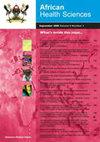66例突尼斯镰状细胞综合征患者的流行病学及临床特征
IF 0.9
4区 医学
Q3 MEDICINE, GENERAL & INTERNAL
引用次数: 0
摘要
镰状细胞综合征(SCS)是一个真正的健康问题。在这项工作中,我们拟研究66例SCS的流行病学和临床特征。 方法:这是一项回顾性描述性横断面研究,对66例SCS患者(36例S/S, 18例S/β-地中海贫血,7例S/C和5例S/OArab)进行了为期两年的研究。结果:人口平均年龄15.5岁±8.4岁。36例(55%)为近亲婚姻,35例(53%)的兄弟姐妹患有SCS。我们患者的平均基线血红蛋白为9.1g/dL±1.51。S/C患者的基线血红蛋白明显高于S/S、S/β-地中海贫血和S/OArab,差异有统计学意义(p <0.05)。仅在S/S、S/β-地中海贫血和S/OArab患者中观察到黄疸、粘膜皮肤苍白和肝脏肿大。脾肿大在S/C中比S/S中更常见,在S/-地中海贫血中比S/S中更常见。最常见的急性并发症是血管闭塞发作(69.7%)和贫血恶化(54.54%)。最常见的慢性并发症是胆石症(36.36%)。结论:S/C患者的耐受性最好,受慢性并发症的影响最小,可基本正常生活。关键词:急性并发症;慢性并发症;镰状细胞综合征;稳定状态。本文章由计算机程序翻译,如有差异,请以英文原文为准。
Epidemiological and clinical characteristics of 66 Tunisian Sickle cell syndrome patients
Introduction: Sickle cell syndrome (SCS) represent a real health problem. In this work, we propose to study the epidemiological and clinical features of 66 patients with SCS.
Methods: This is a retrospective descriptive cross-sectional study carried out on a population of 66 patients with SCS, (36 S/S, 18 S/β-thalassemia, seven S/C and five S/OArab), over a period of two years.
Results: The average age of our population is 15.5 years ± 8.4. 36 patients (55%) were born to a consanguineous marriage and 35 (53%) had siblings with SCS. The average baseline hemoglobin in our patients is 9.1g/dL±1.51. S/C patients have significantly higher baseline hemoglobin than S/S, S/β-thalassemia and S/OArab with p <0.05. Jaundice, mucosal skin pallor and hepatomegaly have been observed only in S/S, S/β-thalassemia and S/OArab patients. The persistence of splenomegaly is more frequent in S/C than in S/S, and in S/-thalassemia than in S/S. The most common acute complications were vaso-occlusive attacks (69.7%) and worsening of anemia (54.54%). The most common chronic complication was cholelithiasis (36.36%).
Conclusion: S/C patients present the best tolerated form and were the least affected by chronic complications and therefore can lead an almost normal life.
Keywords: Acute complications; chronic complications; sickle cell syndrome; steady state.
求助全文
通过发布文献求助,成功后即可免费获取论文全文。
去求助
来源期刊

African Health Sciences
MEDICINE, GENERAL & INTERNAL-
CiteScore
2.30
自引率
0.00%
发文量
179
审稿时长
>12 weeks
期刊介绍:
The African Health Sciences is an internationally refereed journal publishing original articles on research, clinical practice, public health, policy, planning, implementation and evaluation, in the health and related sciences relevant to Africa and the tropics. Its objectives are to: Advocate for and promote the growth of reading culture in sub Saharan Africa; Provide a high quality journal in which health and policy and other researchers and practitioners in the region can and world wide, can publish their work; Promote relevant health system research and publication in the region including alternative means of health care financing, the burden of and solution of health problems in marginalized urban and rural communities amongst the displaced and others affected by conflict; Promote research and the systematic collection and collation and publication of data on diseases and conditions of equity and influence; Promote development of evidence-based policies and guidelines for clinical, public health and other practitioners. African Health Sciences acknowledges support provided by the African Health Journals Partnership Project that is funded by the US National Institutes of Health (through the National Library of Medicine and the Fogarty International Center) and facilitated by the Council of Science Editors.
 求助内容:
求助内容: 应助结果提醒方式:
应助结果提醒方式:


